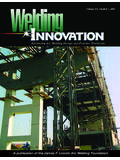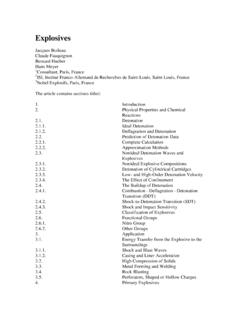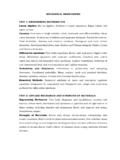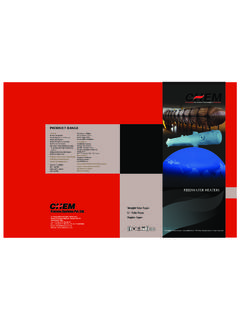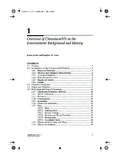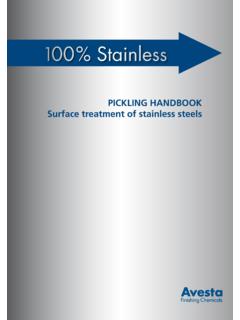Transcription of Economics of Welding - IMPACT
1 Economics of WeldingThe Dollars and Cents behind the Arcs and SparksHow much does Welding actually cost???How can the same weld, have different costs??Real World ExampleRequirement: 3/16 fillet weld 500 Feet Welder C Does not Follows WPS and welds at 180amps Overweldsby 1/8 (makes 5/16 ) Fillet depositing 63lbs more Filler Metal Took additional 70 hours of labor Costs: $3600 WELDERA FOLLOWSWPS OF250 AMPS CREATES3/16 FILLETDEPOSITING35 LBSOFFILLERMETAL TOOK8 HOURSOFLABOR COSTS: $380 WELDERB DOESNOTFOLLOWSWPS ANDWELDSAT225 AMPS OVERWELDSBY1/16 (MAKES ) FILLETDEPOSITING27 LBSMOREFILLERM E TA L TOOKADDITIONAL27 HOURSOFLABOR COSTS: $988 This happens every day!!My goal for today Everyone should understand that welds can cost different amounts and will know how to calculate the costs to make the most economical decision for your company, or at least know that resources exist to make this decisionTopics covered Deposition Rate Deposition Efficiency Welding Process (SMAW, GMAW, FCAW, SAW) Joint Design Welding Volume Arc Time FactorAnd their effect on Welding costs!
2 Deposition Rate Rate that weld metal can be deposited by a given electrode or Welding wire, typically expressed in lbs/hror kg/hr. It is based on continuous production, not allowing time for stops/starts/cleaning or inserting new electrodes. Deposition Rate is directly proportional to the Welding current being used. On a Constant Current Machine increasing the amperage increases the deposition rate For a constant voltage machine increasing the wire feed speed increases the deposition rateDeposition efficiency Relationship of the weight of weld metal deposited vs. the electrode consumed in making the weld. Mostly defined as a percentage. Example: 100lbs of coated electrodes with an efficiency of 65% will result in 65lbs of weld metal (Shielded Metal Arc Welding )SMAW(Shielded Metal Arc Welding Cont d) Advantages.
3 Equipment is Simple and highly portable No shielding gas or flux is required Less sensitive to wind and drafts making it ideal for outdoors Used in limited areas Disadvantages Travel Speeds and productivity are much lower Fume Generation is very high Training time is relatively higher than other processesSMAW(Shielded Metal arc Welding cont d) Electrode SizeCurrentVoltageDepositionRates (lbs/hr)3/32 (Shielded Metal Arc Welding Cont d)ElectrodeLengthDepositionEfficiency2 Stub Loss3 Stub Loss4 Stub Loss5 Stub Loss12 60%65%70%50% 60%65%70% 60%65%70% (Gas Metal Arc Welding )WeldingGunElectrodeFeed UnitPower SourceGMAW(Gas metal arc Welding cont d) Advantages: Has high productivity rate compared to SMAW Has low fume generation rate Requires no de-slagging or cleaning between passes High deposition efficiency Provides low hydrogen deposit to aid in crack avoidance Disadvantages: Requires more control of Welding variables Potential for lack of fusion when not properly applied Sensitive to porosity formation due to less chemicals involved in shielding and slag formers Requires more equipment and investment compared to SMAWGMAW (gas metal arc Welding cont d)Transfer Mode Short ArcTransfer Mode Spray ArcGMAW(Gas metal arc Welding cont d)Wire (WFS IPM)VoltageDeposition Rate (lbs/hr).
4 03075-140 (190-350) (180-300) (125-200) (135-240) (WFS IPM)VoltageDeposition Rate (lbs/hr).030140-200 (440-650) (400-550) (300-500) (265-390) 290-400 (180-280) Rates Short Arc (ER70S-X 75%Ar/25% CO2)Deposition Rates Spray Arc (ER70S-X 98%Ar/2% CO2)Dep. Efficiency 90-97%Cored WiresGAS SHIELDEDSELF SHIELDEDMETAL COREFCAW(FLUX CORED ARC Welding )FCAW(Flux Cored Arc Welding Gas Shielded) Advantages: High Productivity compared to SMAW Excellent out of position Welding capabilities Handles mill scale and rust better than GMAW Broader operating ranges compared to GMAW Disadvantages: Fume generation is higher than other processes Deslagging and cleaning is required between passes Not all types are available in low hydrogen designation Wind can disturb shielding gas and cause porosity FCAW(Flux cored Arc Welding Gas Shielded)Wire diaAmps(WFS IPM)VoltageDeposition Rate(lbs/hr).
5 045145-265 (200-500) (280-600) 195-445 (150-500) 170-320 (125-300) 220-475 (100-300) Cored Arc Welding Process - ER70T-X 100% CO2 Dep. Efficiency 80-90%MCAW(Metal Cored Arc Welding )Current PathMetal Cored WireSolid MIG WireMetal Cored Wires Have A Higher Current DensityResults:Higher Deposition RatesBetter PenetrationBetter Side Wall FusionMCAW(Metal Cored Arc Welding Cont d) Advantages Higher Deposition Rate compare to GMAW/SMAW Better Penetration compared to GMAW Low Fume Generation Out of Position capable (most beneficial with Pulse) No Slag Clean up between passes High Deposition Efficiency compared to FCAW/SMAW Disadvantages High Argon shielding Gas needed More radiant heat compared to FCAW/SMAW Out of Position only capable with Short Arc or Pulse Transfer Susceptible to Wind and loss of shielding gasMCAW(Metal Cored Arc Welding Cont d)Wire (WFS IPM)VoltageDeposition Rate (lbs/hr).
6 045170-360 (200-550) (180-530) 230-510 (150-480) Cored Arc Welding Process E70C-X 90%AR/10%CO2 Dep. Efficiency 91-99%FCAW(Flux Cored Arc Welding Self Shielded)An inside out Stick ElectrodeFCAW(Flux Cored Arc Welding Self Shielded) Advantages No External Shielding gas needed Higher deposition rates compared to SMAW Available for Low Carbon and Low Alloys steels Can be used on Constant Current Welding Machines Out of Position Welding capability makes it great for site work Disadvantages Typically small Welding operating parameters Low Deposition efficiency Very high Fume levels Voltage SensitiveFCAW(Flux Cored Arc Welding Self Shielded) (WFS IPM)VoltageDeposition Rate (lbs/hr).03580-200 (81-392) (54-140) (150-275) (100-300) (150-600) (100-400) Efficiency 74-82%Flux Cored Arc Welding Process E7 XTX No Shielding GasSAW(Submerged Arc Welding )SAW(Submerged Arc Welding ) Advantages No visible arc radiation and very low fume High deposition rates and efficiencies Ability to produce welds that are generally sound and free from defects Unaffected by wind or drafts Ability to add electrodes for increased deposition Disadvantages No visible arc, so tracking is more difficult Addition of flux that must be handled and stores Limited to flat and horizontal positions Motion control is typically used which creates high initial investmentSAW(Submerged Arc Welding )WireDiaAmps (WFS IPM)VoltageDeposition Rate (lbs/hr)3/32 250-700 (55-180) 300-900 (30-125)28-368- 285/32 400-1000 (30-150)
7 28-389- 483/16 500-1300 (20-85)32-4010-421/4 600-1600 (18-60)34-4215-55 SAW Process Carbon Steel of Flux per lb. of Electrode Dep. Efficiency 97-99%Types of Joint DesignsFillet WeldSquare BevelK BevelSingle VDouble VSingle BevelDetermining Total Cost of Weld Total Weld Cost= Total Arc Time + Non Arc Time + Filler MetalHow much will it cost to make the weld? (Total Arc Time) Determine Weld Metal Volume Needed Determine Deposition rate for Given Process Calculate Total Time needed to make weldDetermine Weld Metal Volume First determine cross sectional area (Use Fillet Weld First)-Toe Length s will be Equal to Sides of a Triangle-Calculation = Leg X Leg 2-EX. Equal Leg Fillet Area = .03125 = Length X Area- Fillet Weld 100 Long = (.03125 X 1200) = Cu. In-Volume = Total Area X Density = X .283 = Rate Comparison Use 1/8 E7018 SMAW Electrode 120 Amps = = * $35 L/OH = $ Use 1/16 E71T-8 FCAW-S 205 Amps = = * $35 L/OH = $ the 100 Long Fillet Weld Requiring of Weld MetalDetermine Filler Metal Needed Use 14 1/8 E7018 SMAW Electrode 3 Stub Loss = 55% Dep.
8 Efficiency 55% = @ $ $ Use 1/16 E71T-8 FCAW-S 205 Amps = = @ $ the 100 Long Fillet Weld Requiring of Weld MetalDetermine Non Arc Time Factors Effecting Non-Arc Time InterpassCleaning Electrode Change Out Welder Position Change Weld Joint Preparation Fitting/TackingArc Welding processDuty cycle %MMA (SMAW)15 - 30 TIG (GTAW)25 - 40 Mechanized TIG80 - 90 MIG/MAG (GMAW)30 - 45 Mechanized MIG/MAG80 - 90 Sub Arc (SAW)80 - 95 FCAW25 - 45 Mechanised FCAW70 - 85 MCAW30 - 45* Non Arc Time SMAW 25% Operating Factor 25% OF = * $35 L/OH = $ FCAW S 35% Operating Factor 35% OF = * $35 L/OH = $ the 100 Long Fillet Weld Requiring of Weld MetalAdding it All up SMAW $ +$ +$ = $ FCAW-S $ +$ +$ = $ Time + Non + FM = Total CostDifference of $ Effecting Weld Volume OverweldingFillet Welds can have dramatic consequences.
9 EX. 5/16 made instead of = 43% More Volume Exponential change in Cost of WeldLets do the Math 5/16 Fillet 100 Long 5/16 *5/16 2 = .0488 .0488 * 1200 *.283 lb/Cu In = Cost Comparison 1/8 E7018 Electrode @ 120 Amps * $35/hr= $ 55% = * $ $ 25%OF = * $35/hr= $ $1, 1/16 E71T-8 FCAW-S @ 205 Amps * $35/hr= $ = * $ $ 35%OF = * $35/hr= $ $ OveweldingCosts SMAW Fillet = $ 5/16 Fillet = $1, Difference $ FCAW-S Fillet = $ 5/16 Fillet = $ Difference $ Look at a GirderGirder Specifications 50 Long 3 Flange Thickness 2 Web Thickness Current Design Double Bevel Weld Root Face = 0 Bevel Angle = 45 Unequal Fillet Outside of Groove45 2 First Calculate the Joint Area Finding Cross sectional area of Triangle we use Trig Ta n =Opposite Side Adjacent Side Therefore Tan(45)*1 = 1 Cross Section = 1*1.
10 5 = .5 Sq. In .5 * 50 *.283 = per Weld Total for Bevel2 Calculate Joint Area of Fillet Bottom Leg x 1 Top leg .5 X 1 = .25 .25 x 50 = per Weld for Filets Total Weld Volume for Girder Bevels Filets TotalSelecting Welding Process 3/32 Submerged Arc Welding 600 Amps Deposition Rate = 22lbs/hr 22lbs = * $35 L/OH = $ .99% Dep. Eff = * = Flux ( *$ )+( *$ ) = $2, FM Costs 50%OF = * $35 L/OH = $ Cost for Girder Welding Total Arc Time = $ Total Non Arc Time = $1, Total Filler Metals = $2, Total Cost = $4, Happens if we make some Changes Change Joint Design to Double Bevel with 3/16 Land 40 Bevel Angle Find the Leg Lengths 2-3/16 = 2 = .90625 Tan(40) = .90625 B .839 * .90625 *.5 = .38 .38 sq/In* 50 * .283 = for BevelsCalculating Total Weld Volume .839 X.
